Study on the Effects of Different Thawing Methods on the Thawing Efficiency of Pork
Abstract
:1. Introduction
2. Materials and Methods
2.1. Experimental Materials
2.2. Experimental Equipment
2.3. Thawing Methods
2.3.1. Natural Air Thawing (NAT)
2.3.2. Vacuum Steam Thawing (VST)
2.3.3. Vacuum Sublimation–Rehydration Thawing (VSRT)
2.4. Determination of Thawing Quality Indicators
2.4.1. Thawing Time
2.4.2. Thawing Loss Rate
2.4.3. Color Measurement
2.4.4. Texture Parameter
2.4.5. System Specific Energy Consumption
2.5. Statistical Analysis
3. Results
3.1. Analysis of the Thawing Process
3.2. Thawing Loss
3.3. Color Analysis
3.4. Texture Parameters
3.5. System-Specific Energy Consumption
4. Conclusions
- (1)
- The VSRT method achieved the shortest thawing time of 54.60 min, reducing the processing time by 55.37% compared to NAT and by 34.61% compared to VST;
- (2)
- VSRT demonstrated superior quality retention with the lowest thawing loss rate and total color difference. Specifically, it reduced the thawing loss rate by 85.66% and 79.27% compared to NAT and VST, respectively, and minimized the total color difference by 87.04% and 82.76%;
- (3)
- VSRT effectively maintained texture properties similar to fresh meat, with no significant differences (p > 0.05). In contrast, VST caused significant changes in texture parameters: hardness and chewiness increased, while adhesiveness and cohesiveness decreased significantly (p < 0.05);
- (4)
- The total specific energy consumption of VSRT was 26.97 × 10−3 kWh/kg, which was much lower than that of VST. Compared with the VST system, the specific energy consumption of the system can be reduced by up to 40.67%.
Author Contributions
Funding
Data Availability Statement
Acknowledgments
Conflicts of Interest
References
- Guo, S.; Lin, T.; Wang, D.; Zhu, Z. International Livestock Products Market Situation in 2023 and Outlook in 2024. Chin. Livest. Poult. Breed. 2024, 20, 47–52. [Google Scholar]
- Coombs, C.E.O.; Holman, B.W.B.; Friend, M.A.; Michael, A.F. Long-term red meat preservation using chilled and frozen storage combinations: A review. Meat Sci. 2017, 125, 84–94. [Google Scholar] [CrossRef] [PubMed]
- Sutariya, S.G.; Sunkesula, V. Food Freezing: Emerging Techniques for Improving Quality and Process Efficiency a Comprehensive Review. In Innovative Food Processing Technologies; Elsevier: Amsterdam, The Netherlands, 2021; pp. 36–63. [Google Scholar] [CrossRef]
- Zeng, J.; Li, Y.; Zou, Y.; Yang, T.; Zhou, Y. Intestinal toxicity alleviation and efficacy potentiation through the rapeutic administration of Lactobacillus paracasei GY-1 in the treatment of gout flares with colchicine. Food Funct. 2024, 15, 1671–1688. [Google Scholar] [PubMed]
- Zhao, H.; Liu, S.; Tian, C.; Yan, G.; Wang, D. An overview of current status of cold chain in China. Int. J. Refrig. 2018, 88, 483–495. [Google Scholar]
- Dong, J.; Kou, X.; Liu, L.; Hou, L.; Li, R.; Wang, S. Effect of water, fat, and salt contents on heating uniformity and color of ground beef subjected to radio frequency thawing process. Innov. Food Sci. Emerg. Technol. 2021, 68, 102604. [Google Scholar] [CrossRef]
- Cai, L.; Cao, M.; Cao, A.; Joe, R.; Li, J.; Guan, R. Ultrasound or microwave vacuum thawing of red seabream (Pagrus major) fillets. Ultrason. Sonochem. 2018, 47, 122–132. [Google Scholar] [CrossRef]
- Peng, Z.; Zhu, M.; Zhang, H.; Yao, D.; Ma, C.; He, H.; Wang, Z.; Zhao, S.; Du, K.; Ma, H. Improved quality characteristics of pork thawed at low-temperature and high-humidity. Food Ferment. Ind. 2019, 45, 79–85. [Google Scholar]
- Jin, Z.; Zhao, Y.; Zhang, M.; Guo, R.; Liu, D. Progress in Meat thawing technologies. Meat Res. 2022, 36, 57–66. [Google Scholar]
- Li, N.; Xie, J.; Zhou, R.; Tang, Y.; Zhou, Y.; Xu, H. Effects of vacuum-steam thawing on the sense of tuna. J. Refrig. 2014, 35, 76–82. [Google Scholar]
- Bailey, C.; James, S.J.; Kitchell, A.G.; Hudson, W.R. Air-, water- and vacuum-thawing of frozen pork legs. J. Sci. Food Agric. 1974, 25, 81–97. [Google Scholar]
- Wang, B.; Du, X.; Kong, B.; Liu, Q.; Li, F.; Pan, N.; Xia, X.; Zhang, D. Effect of ultrasound thawing, vacuum thawing, and microwave thawing on gelling properties of protein from porcine longissimus dorsi. Ultrason. Sonochem. 2020, 64, 104860. [Google Scholar] [PubMed]
- Song, R.; Zou, T.; Zhang, K.; Han, X. Effect of vacuum thawing process on pork quality. Food Sci. Technol. 2019, 44, 119–124. [Google Scholar]
- Chen, S.; Wu, W.; Yang, Y.; Wang, H.; Zhang, H. Experimental study of a novel vacuum sublimation–rehydration thawing for frozen pork. Int. J. Refrig. 2020, 118, 392–402. [Google Scholar]
- Zeng, M.; Zou, Y.; Shi, Z.; Wang, J.; Yang, Y.; Bai, Y.; Ping, A.; Zhang, P.; Chen, Y.; Tao, H.; et al. A broad-spectrum broth rapidly and completely repairing the sublethal injuries of Escherichia coli caused by freezing and lactic acid alone or in combination for accurate enumeration. LWT 2024, 201, 116–219. [Google Scholar]
- Kopeć, A.; Mierzejewska, S.; Bać, A.; Piepiórka-Stepuk, J. Modification of the vacuum-steam thawing method of meat by using the initial stage of sublimation dehydration. Sci. Rep. 2022, 12, 1–9. [Google Scholar]
- Hui, Q.; Zou, T.; Song, R.; Zhang, K. Effects of different freezing methods on the quality of vacuum thawing pork. Food Ferment. Ind. 2020, 46, 115–120. [Google Scholar]
- Chen, S. Theoretical and Experimental Study on a Novel Vacuum Sublimation-Rehydration Thawing Method. Ph.D. Thesis, University of Shanghai for Science & Technology, Shanghai, China, 2022. [Google Scholar]
- Yu, C.; Lu, S.; Zhou, Z. Practical Handbook of Refrigeration and Air Conditioning Engineering, 2nd ed.; Machine Press: Beijing, China, 2011; pp. 545–546. [Google Scholar]
- Lopez-quiroga, E.; Antelo, T.A.; Alonso, A.A. Optimal time-scale modeling and control of freeze-drying. J. Food Eng. 2012, 111, 655–666. [Google Scholar]
- Chen, S.; Wu, W.; Mao, S.; Li, K.; Zhang, H. Optimization of a novel vacuum sublimation-rehydration thawing process. Food Sci. 2023, 88, 259–272. [Google Scholar]
- Liu, F.; Zhang, R.; Li, F.; Qu, Y. Influence of thawing ways on thawing effects and gel properties of frozen surimi. J. Shandong Agric. Univ. (Nat. Sci. Ed.) 2019, 50, 681–685. [Google Scholar]
- Wang, Y.; Yan, J.; Ding, Y.; Ma, H. Effects of ultrasound on the thawing of quick-frozen small yellow croaker (Larimichthys polyactis) based on TMT-labeled quantitative proteomic. Food Chem. 2022, 366, 130600. [Google Scholar]
- Chen, S.; Wu, W.; Liu, F.; Zhang, H.; Yang, W. Experimental study on the effect of heating plate (heat source) temperature on a new vacuum sublimation-rehydration thawing. Int. J. Refrig. 2022, 136, 27–35. [Google Scholar]
- Li, S.; Wu, W.; Chen, S.; Liu, F.; Wang, X. Experimental study on the effect of different rehydration water volume on novel vacuum sublimation-rehydration thawing. J. Refrig. 2024, 45, 159–166. [Google Scholar]
- Zhang, D.; Sun, J.; Wang, X.; Shang, Y.; Peng, Z. Effects of freeze-thaw cycle on the quality properties and microstructure of rabbit muscle. Food Sci. 2014, 35, 38–42. [Google Scholar]
- Zheng, X.; Zeng, L.; Bai, X.; Wang, C.; Hou, A. Effects of different thawing methods on pork physicochemical properties and microbial counts. Meat Res. 2018, 32, 14–19. [Google Scholar]
- Wang, L.; Chen, W.; Wang, Y.; Li, Z.; Xia, D. Effects of thawing methods on the quality, physicochemical properties and microstructure of pork. Food Mach. 2023, 39, 35–41. [Google Scholar]
- Wang, B.; Bai, X.; Du, X.; Pan, N.; Shi, S.; Xia, X. Comparison of effects from ultrasound thawing, vacuum thawing and microwave thawing on the quality properties and oxidation of porcine longissimus lumborum. Foods 2022, 11, 1368. [Google Scholar] [CrossRef]


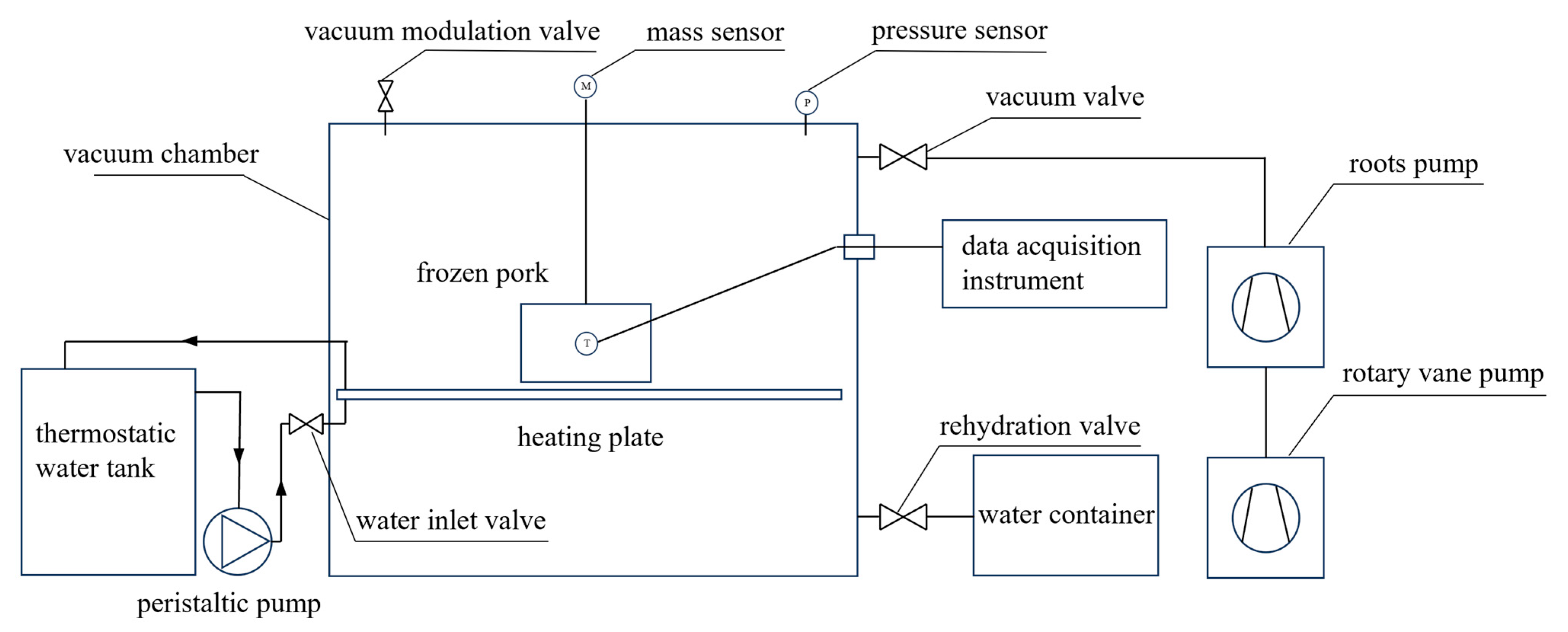
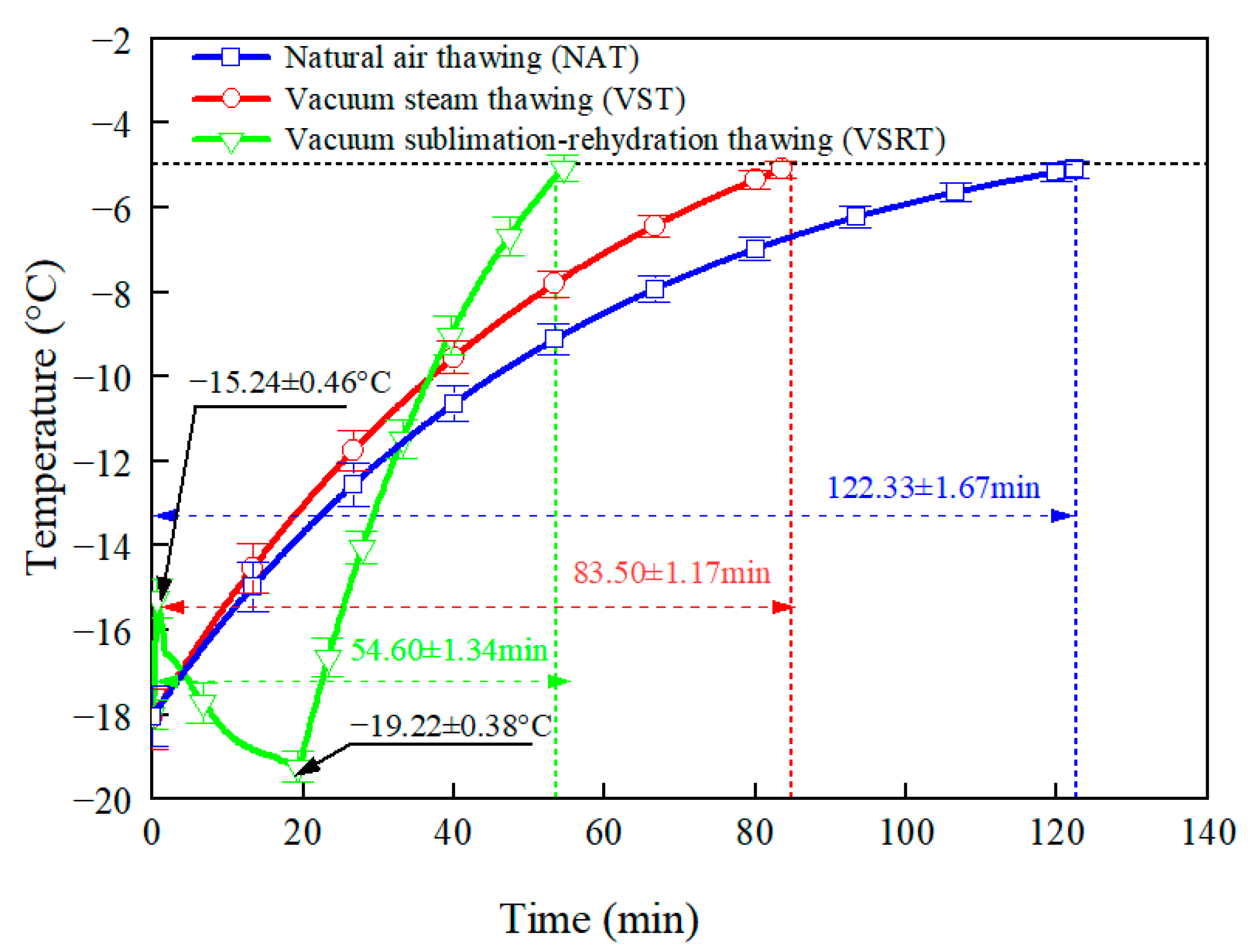
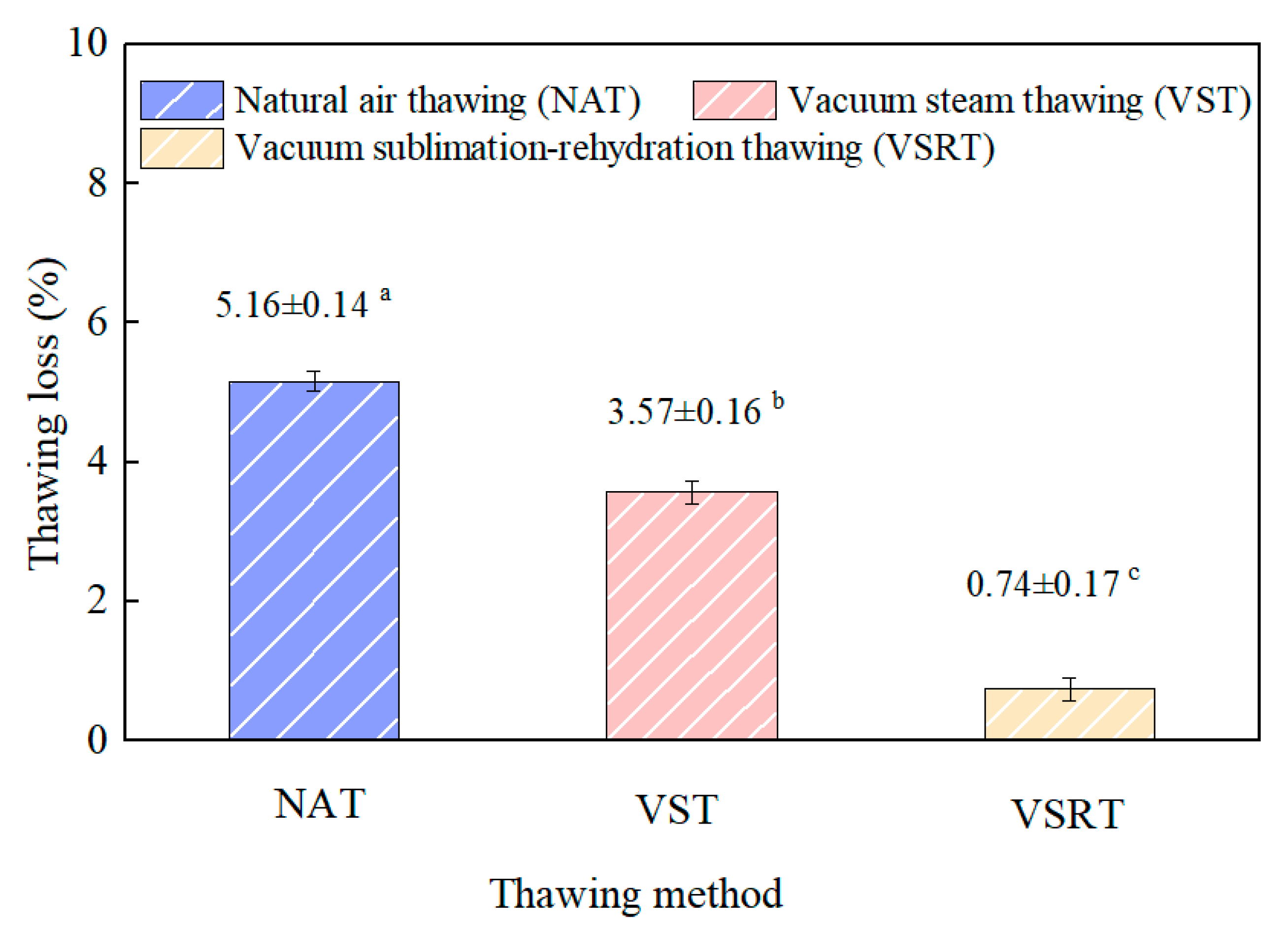
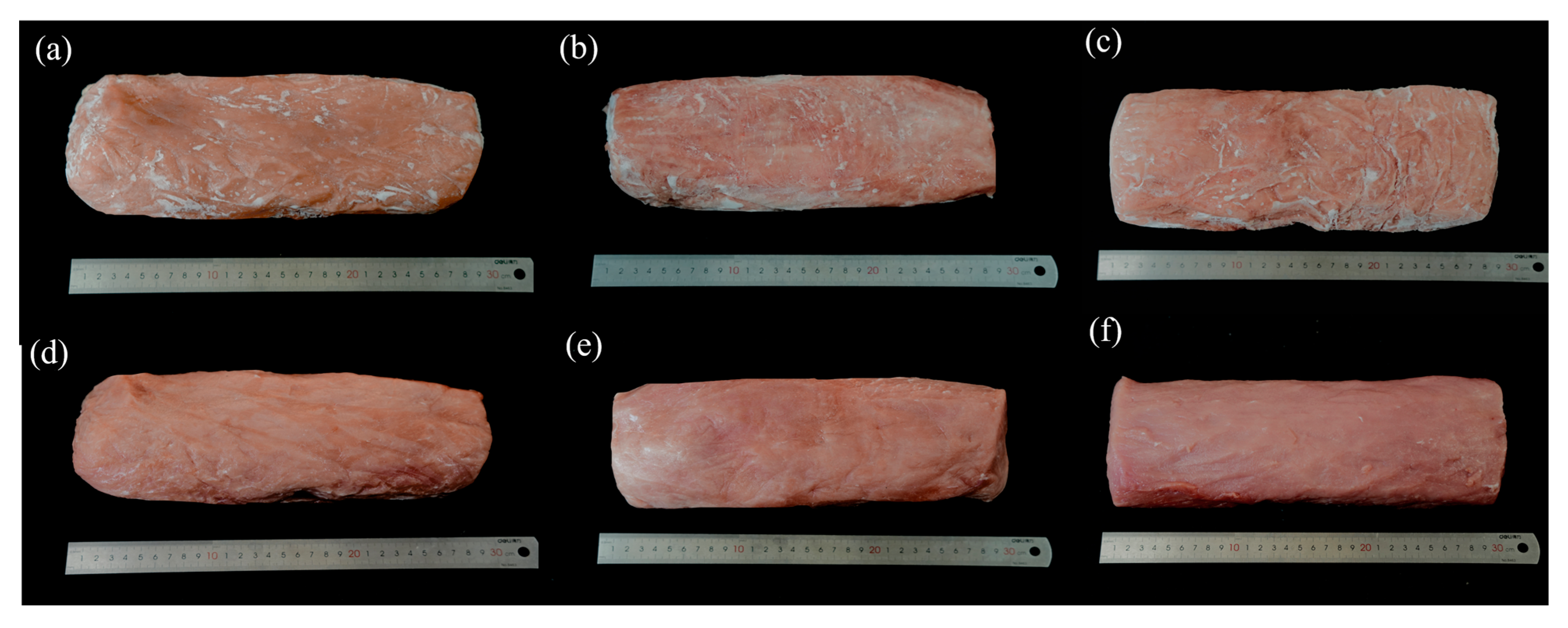
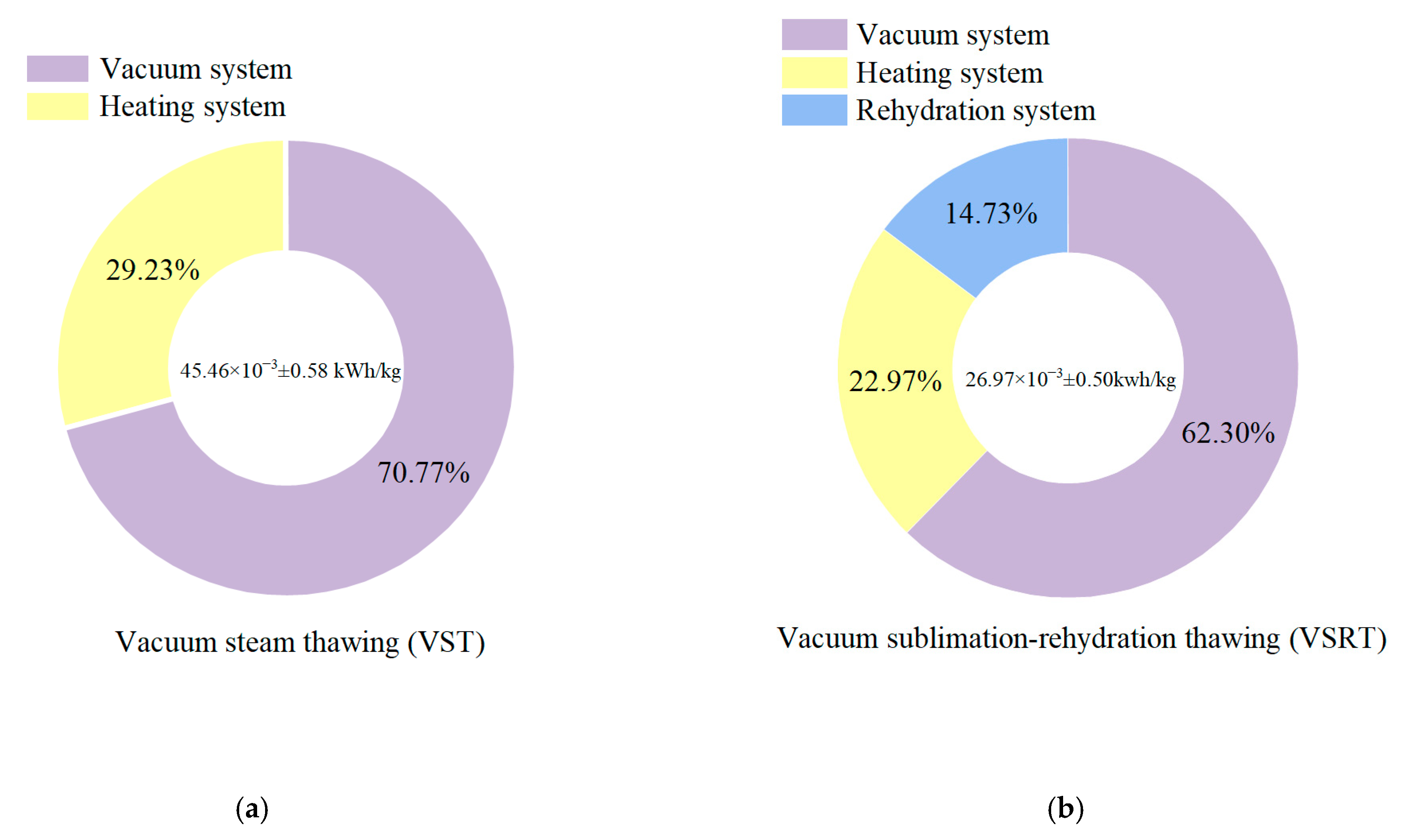
| Instrument Name | Manufacturer/Brand (Model), Country | Parameter | Precision |
|---|---|---|---|
| Vacuum steam thawing machine | Dachang Air Conditioning Equipment Engineering Co., Ltd., Guangzhou, China | Limit of pressure 100 Pa | |
| Rotary vane pump | Leybold SOGEVAC (SV40B), Leybold Co., Ltd., Cologne, Germany | Limit of pressure 150 Pa | - |
| Roots pump | ZJP-70, Tiantian Vacuum Equipment Manufacturing Co., Ltd., Jiangyin, China | Limit of pressure 0.05 Pa | - |
| Pressure sensor | GE-Druck (UNIK5000), Baker Hughes Company, Billerica, MA, USA | Range 0~100 kPa | ±0.04% FS |
| Temperature sensor | Omega TT-T-30, Omega Engineering, Inc., Stamford, CT, USA | Range −200~350 ° C | ±0.5 °C |
| Mass sensor | JLBS-M2, Bengbu Sensor System Engineering Co., Ltd., Bengbu, China | Range 0~3 kg | ±0.5 g |
| Electronic scale | Sartorius (BSA3202S), Sartorius AG, Gottingen, Germany | Range 0~3.2 kg | ±0.01 g |
| Color difference meter | Konica Minolta (CR-400), Konica Minolta Sensing, Inc., Tokyo, Japan | Range: 0.01~160% (reflectivity) | ±6% FS |
| Power meter | UNI-T (UT230E), UNI-Trend Technology Co., Ltd., Dongguan, China | Range 0.001~9999 kWh | ±1% Rdg |
| Parameter | Total Color Difference | Brightness | Redness | Yellowness |
|---|---|---|---|---|
| Fresh meat | - | 52.40 ± 0.15 b | 5.76 ± 0.18 a | 6.38 ± 0.16 b |
| NAT | 8.10 ± 0.16 a | 44.74 ± 0.16 c | 4.26 ± 0.15 b | 8.56 ± 0.15 a |
| VST | 6.09 ± 0.12 b | 58.24 ± 0.16 a | 4.31 ± 0.16 b | 5.41 ± 0.16 b |
| VSTR | 1.05 ± 0.03 c | 53.29 ± 0.15 b | 5.80 ± 0.17 a | 6.94 ± 0.18 b |
| Parameter | Hardness (g) | Springiness | Adhesiveness (g · s) | Cohesiveness | Chewiness |
| Fresh meat | 1586.50 ± 35.12 b | 0.78 ± 0.01 b | 7.64 ± 0.02 a | 0.71 ± 0.02 b | 735.62 ± 25.46 a |
| NAT | 2450.75 ± 257.20 a | 0.88 ± 0.04 a | 5.03 ± 0.04 b | 0.92 ± 0.02 a | 1432 ± 39.78 b |
| VST | 2100.34 ± 40.15 a | 0.73 ± 0.03 b | 5.12 ± 0.02 b | 0.57 ± 0.01 c | 984.76 ± 32.16 c |
| VSTR | 1600.36 ± 35.12 b | 0.75 ± 0.01 b | 7.79 ± 0.01 a | 0.68 ± 0.01 b | 745.63 ± 24.85 a |
| Parameter | Vacuum System | Heating System | Rehydration System | Total |
|---|---|---|---|---|
| NAT | - | - c | - | - |
| VST | 32.20 ± 0.36 × 10−3 a | 13.30 ± 0.22 × 10−3 a | - | 45.46 ± 0.42 × 10−3 a |
| VSTR | 16.80 ± 0.28 × 10−3 b | 6.20 ± 0.16 × 10−3 b | 3.97 ± 0.06 b | 26.97 ± 0.33 × 10−3 b |
Disclaimer/Publisher’s Note: The statements, opinions and data contained in all publications are solely those of the individual author(s) and contributor(s) and not of MDPI and/or the editor(s). MDPI and/or the editor(s) disclaim responsibility for any injury to people or property resulting from any ideas, methods, instructions or products referred to in the content. |
© 2025 by the authors. Licensee MDPI, Basel, Switzerland. This article is an open access article distributed under the terms and conditions of the Creative Commons Attribution (CC BY) license (https://creativecommons.org/licenses/by/4.0/).
Share and Cite
Xue, A.; Chen, S.; Sun, Y. Study on the Effects of Different Thawing Methods on the Thawing Efficiency of Pork. Processes 2025, 13, 1067. https://doi.org/10.3390/pr13041067
Xue A, Chen S, Sun Y. Study on the Effects of Different Thawing Methods on the Thawing Efficiency of Pork. Processes. 2025; 13(4):1067. https://doi.org/10.3390/pr13041067
Chicago/Turabian StyleXue, Anyuan, Shanshan Chen, and Yuyao Sun. 2025. "Study on the Effects of Different Thawing Methods on the Thawing Efficiency of Pork" Processes 13, no. 4: 1067. https://doi.org/10.3390/pr13041067
APA StyleXue, A., Chen, S., & Sun, Y. (2025). Study on the Effects of Different Thawing Methods on the Thawing Efficiency of Pork. Processes, 13(4), 1067. https://doi.org/10.3390/pr13041067





